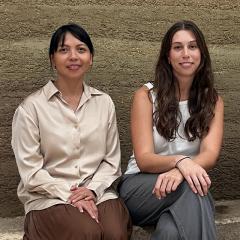An interest in heritage and adaptive reuse led Lloyd Jones to undertake a PhD research project on architect, Robin Gibson. Lloyd joins us this week to tell us more about this important research work.
Tell us about your career path and how it has evolved over time?
I completed both my Bachelor and Masters degrees at the University of Queensland. During 4th year, I successfully applied to the Summer Research Scholarship program, having enjoyed the more focused research component of the Masters course. This was a turning point for me as the project I worked on over the summer involved researching post-war architecture in Queensland. I found it fascinating that there was so much world class architecture, right in my backyard! I continued to pursue this interest throughout the remainder of the degree.
During my time as a Masters student I was also drawn to the heritage and adaptive reuse projects run as design studios. I was able to put these skills into practice after graduating when I worked as a heritage consultant.
I was actually emailed about my PhD project by my supervisor, who thought I would be a good fit for the project. To me, Gibson was the ultimate post-war Queensland architect, having completed some of the most significant projects during this period. Although it wasn’t really my intention to do a PhD at this time, I jumped at this opportunity and successfully applied to the UQ HDR program. I have also been fortunate to continue working in architectural heritage throughout my PhD, both within the Queensland Department of Heritage and as a private consultant.
What’s your PhD about?

My PhD aims to document the work of Robin Gibson. Gibson’s most well-known project is the Queensland Cultural Centre, located at Southbank in the heart of Brisbane, but he completed significant buildings throughout Queensland and interstate, even at the University of Queensland! Despite Gibson’s prominence, there has been very little written on Gibson, his complete body of work or the practice that carried his name, Robin Gibson & Partners.
My research aims to change this, drawing attention to how Gibson’s love of Brisbane – its climate, its historical context and the lifestyle of its people – manifested in his projects of various scales and types, all of which feature Gibson’s signature high standard of design and finish. My thesis examines not only the buildings themselves, but the structure of the practice, and the tensions that exist between Gibson as the principle architect of a major office, and the collaborative nature of architecture.
What does a typical day in the life of a PhD student look like?
I’m not sure there is a typical day for a PhD student! Everyone in the HDR cohort are doing such varied and amazing things that I’m not sure any of us ever have days which are too similar. My particular approach to this project has meant that although there are some days spent reading and writing, I spend a lot of time outside the office. One of my main research methods has been collecting oral histories and so I’ve been able to interview architects I’ve long admired, meet with former clients of Gibson’s as well as his friends and family. I’ve also been able to work closely with his personal archive and visit some amazing buildings.
Throughout my PhD, I’ve tried to engage the public with my research as much as possible. I’ve done walking tours of Gibson’s work in the CBD for Brisbane Open House, appeared on ABC Radio and was even asked to speak at the re-opening of Gibson’s Central Library at UQ after it was renovated in 2019.
What are you enjoying most about studying at UQ?
The research culture within the School of Architecture is really strong. There are so many really interesting and varied research projects which both faculty staff and other HDR students are working on, including traditional historical and archival based research as well as design and materials focused research. This makes for a really rich research culture and interesting discussions around the espresso maker!
There are also so many opportunities offered to UQ, HDR students. For example, in 2018 I was fortunate to receive the UQ Guilford Bell Scholarship. I used this grant to recreate Gibson’s 1973 tour of international art galleries, spending 5 weeks abroad on a whirlwind trip, visiting galleries in England, Denmark, The Netherlands and the USA.
What advice would you offer students looking to start a PhD?
Some weeks it will feel like very little progress has been made, try not to get too hung up on this, as other weeks it will feel like you’re making breakthrough after breakthrough.
Remember, it’s a marathon not a sprint, and every step however small, will help you get you to where you want to be. Also, take the time to get to know your fellow students.
What might sound like a completely different research project or approach could actually lead to some really exciting collaborations.



